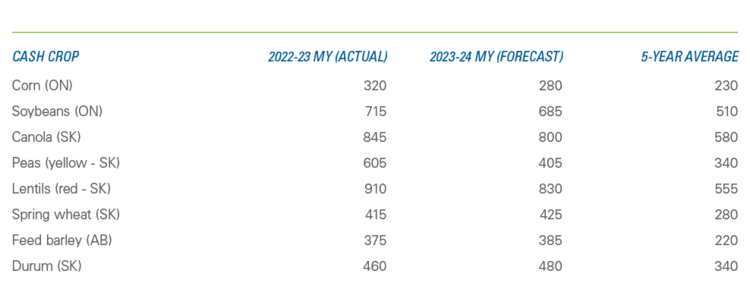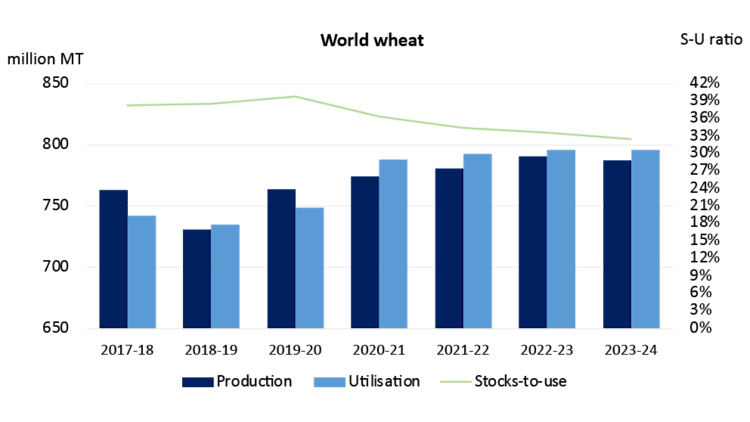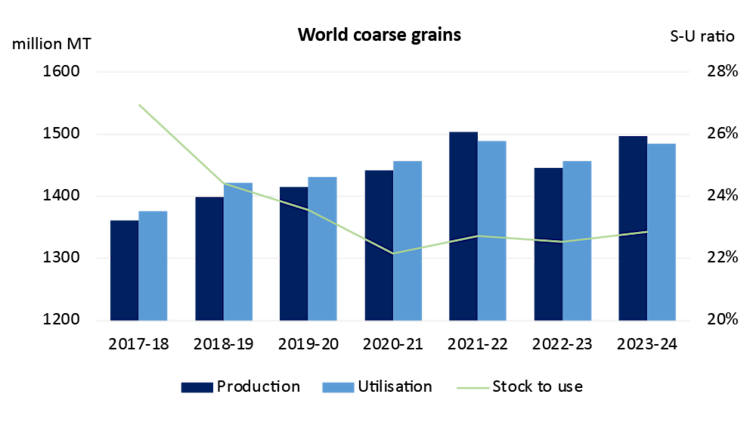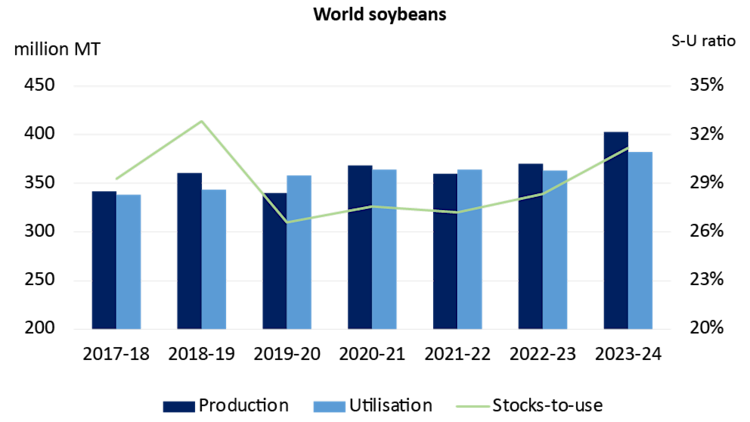2023 Grains, oilseeds and pulses outlook update: Profitability pressures due to a perfect storm of events

This is the third and final quarterly update to our 2023 Outlook for major crops published in January. Over the next two weeks, we’ll update our Outlooks for dairy and cattle and hogs.
Has the tide turned? The last three years have been good for Canadian crop producers: rising prices and strong margins have been hallmarks of the 2020s. But as margins are pressured by falling commodity prices, weather-impacted yields, and rising expenses, the 2023-24 crop year likely won’t be as positive. Our July outlook identified global stocks levels, input costs, weather and geopolitical turmoil as profitability-related factors to monitor throughout the summer. With most crops in bins, we forecast their various impacts on margins for the year ahead.
As prices fall, drought takes another bite out of Canadian production
Throughout the 2022-2023 marketing year (MY), average prices for canola and spring wheat fell year-over-year (YoY), while prices for the other major field crops continued to rise (Table 1). In the three months since our July outlook, they have generally outperformed our forecast. Corn and canola prices have fallen since then but are still above their five-year averages.
The new crop prices also remain above their five-year averages, but most will fall YoY. Only feed barley, durum and spring wheat are expected to improve over the outlook period.
Table 1: Most new crop prices ($/tonne) fall YoY

Sources: Statistics Canada, AAFC, USDA, PDQ, CanFax, CME, MGEX and ICE Futures, and FCC calculations
Marketing Year for corn and soybeans: September 1 – August 31
Marketing Year for wheat, canola, barley, peas and lentils: August 1 – July 31
While not as severe as the 2021 drought, the lack of moisture in Western Canada has limited overall production. Based on Statistics Canada’s September 14, model-based principal field crop estimates, production of each major field crop has fallen YoY, with overall production declining 13% and 8.3% lower than the five-year average. The West’s production is down 17.1% YoY. Yields for grains, oilseeds and pulses have all fallen YoY, although they’re expected to be better than the 2021 crop’s yields. And corn and soybeans projected outputs are marginally higher than last year due to larger harvested areas.
But whereas in 2021, when Canadian production was even more limited, high and rising commodity prices were able to boost farm cash receipts. In 2023, constrained overall supplies are in a lower-price environment – a double whammy for total revenues.
Input prices are still a factor to contend with
It doesn’t get much easier for the other part of the income statement. As crop prices weaken and production slows, expenses are an important factor to monitor. The wild jumps in input prices that have challenged the crop sector are waning as fertilizer prices come down from their 2022 highs (Table 2). Fertilizer prices are expected to continue softening until the end of the calendar year, trending slightly higher by seeding time. Overall, we expect wholescale improvement for the seeding of the 2024-25 crop year as each input’s downward price trends stabilizes.
Table 2: Changes in farm input prices in 2024-25 are expected to moderate as prices drop

Sources: Alberta Farm Inputs, World Bank, FCC calculations (* rolling average)
Taken together, these three factors will mean increased pressure on 2023-24 crop production profitability. In the east (corn-soy rotation) and the west (canola-wheat rotation), margins are expected to fall compared to their respective five-year averages. Pressures on barley, canola, yellow peas, spring wheat, durum and red lentils will be stronger than for the East’s winter wheat and corn. We expect soybean production to remain profitable throughout the outlook period.
Global stocks of corn and soybeans ease; wheat and canola remain tight
The USDA’s most recent forecast calls for world 2023-24 ending wheat stocks to be the lowest since 2015-16. The stocks-to-use ratio continues to drop (Figure 1).
Figure 1: Growth in wheat’s total use tops growth in production

Source: USDA
That should signal higher wheat prices, but prices for hard red winter wheat (the top wheat export for the U.S.) slumped to a three-year low in mid-September. Part of that is due to expected bumper crops in Russia, the world’s largest wheat exporter.
Other bearish factors are helping to depress wheat prices. Ukraine has successfully navigated the Black Sea with shipments and is working on establishing routes out of the country that are less vulnerable to Russian aggression. Markets seem to have already priced in the uncertainty underlying the region. Turkey has a bumper crop and is exporting more than expected. The relatively lower quality of wheat from war-torn countries and those facing poor weather may be driving prices down, too.
Even if prices do rise, there’s only so much Canadian wheat. Supplies as of September include the lowest ending stocks (2022-23) of durum on record and a 30% YoY reduction in the 2023-24 crop due to drought in Western Canada. Non-durum ending stocks for the 2022-23 crop year were the second lowest on record, while 2023-24 production was 10% lower YoY and 2% lower than the previous five-year average. Based on the lower prices and limited production, margins will likely be tight for the East’s winter wheat and more heavily pressured for Western spring wheat.
Corn
With a 10.2% YoY increase in U.S. production, world corn-ending stocks are forecast 4.9% higher YoY. The lower ending global stocks for the 2022-23 MY kept them from being even higher. New crop production is expected to increase 5.1% YoY while total use (domestic use and exports) grows 3.5% YoY. Overall, coarse grains are also up YoY, with a small improvement in the stocks-to-use ratio (Figure 2).
Figure 2: An excellent U.S. corn crop in 2023 helps raise the world's coarse grains stocks-to-use ratio

Source: USDA
Canadian 2022-23 corn carry-out stocks are the lowest since 2014-15, but on the basis of YoY higher seeded and harvested areas in 2023-24, AAFC estimates production to be 3% higher YoY. Final 2023-24 ending stocks are fully 25% higher YoY. With the year’s average prices likely to drop closer to the most recent five-year average, profitability should be close to the break-even point.
Soybeans
As reported in our July update, global soybean stocks do not bode well for prices after Brazil’s huge harvests in 2022 and 2023, with a corresponding increase in the stocks-to-use ratio (Figure 3).
Figure 3: Soybean prices pressured by rising stocks-to-use ratio

Source: USDA
China’s record high imports (102.0 million tons) should put a dent in those stocks, and further global demand for vegetable oil may still top current expectations. Since the early summer months of May/June, when they were generally the lowest in the last year (October – September), all oil prices have improved. But there are caveats. August prices were lower than July’s, and the average 2022-23 price (October to August) is still well below 2021-22.
For the 2023-24 MY, AAFC forecasts total supply to grow 2.6%. Production is expected to rise YoY, but with 6.7% growth in exports from strong demand, ending stocks will decline to 300,000 tonnes. Plus, while Canadian prices are expected to fall 4.2% YoY — at which point they’ll still easily exceed the five-year average — they’ll find support in the CAD/USD exchange rate. Margins should continue to be positive this MY.
Canola
Global rapeseed production is expected to fall in the 2023-24 MY, as Canadian canola production is forecast to have declined 7.1% YoY. Although Canada’s total supply won’t fall as much as it did after the drought of 2021, it’s still expected to see a 5.8% drop YoY and an 11.6% decline from the five-year average. And despite our exports and domestic use both falling YoY, ending stocks are forecast to tumble a steep 33.6%, helping to keep prices elevated this year. The boost to soybean prices from strong global demand for vegetable oil will hold for canola as Canadian and global processing capacity grows.
Although expected to fall from their highs last year, prices will remain elevated well above their five-year average.
Lentils and peas
Typically Canada’s largest export market for pulses, India, will bear an outsized influence on Canadian pulse growers’ profits this year. The country faces challenges ensuring food security with an election around the corner. Food inflation is high (9.9%), and poor domestic yields due to unfavourable weather have hampered production. They’ll almost certainly need to import raw food commodities. Still, the country is embroiled in a political controversy with Canada’s government that threatens to keep Canadian commodities out of the market.
It’s unclear if political tensions will translate to a deterioration in trade relations between the two countries. However, Canada is essentially the only supplier of green lentils whose supply is currently very tight in India. And that’s likely to mean Canadian lentils may benefit from a premium as the stocks-to-use ratio is expected to stand at 9% for the 2023-24 MY. Peas aren’t much better after the dry conditions this year led to a 33.6% YoY decline in production and an expected 24.7% drop in carryout stocks.
Prices are expected to fall YoY based on uncertain demand, but although they’ll remain higher than the five-year average, they won’t fully support profitability. Some operations may see red ink this year.
Bottom line
After several good years, a perfect storm has landed amid Canadian crop growers. Along with reduced production, crop prices have faded from their highs. And the premium for Russia’s war on Ukraine has perhaps been paid in full.
Make no mistake: strong global demand and the loonie will bolster most sectors’ revenues. However, dropping prices and weather-constrained production risks will necessitate a realistic risk management plan.

Martha Roberts
Economics Editor
Martha joined the Economics team in 2013, focusing on research insights about risk and success factors for agricultural producers and agri-businesses. She has 25 years’ experience conducting and communicating quantitative and qualitative research results to industry experts. Martha holds a Master of Sociology degree from Queen’s University in Kingston, Ontario and a Master of Fine Arts degree in non-fiction writing from the University of King’s College.
